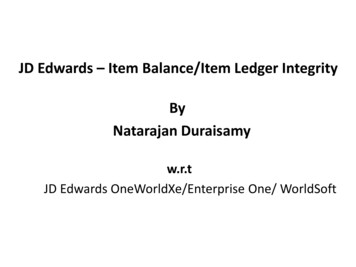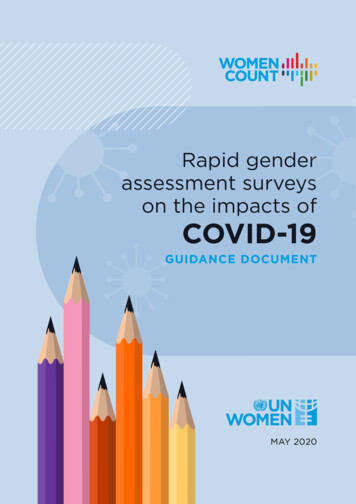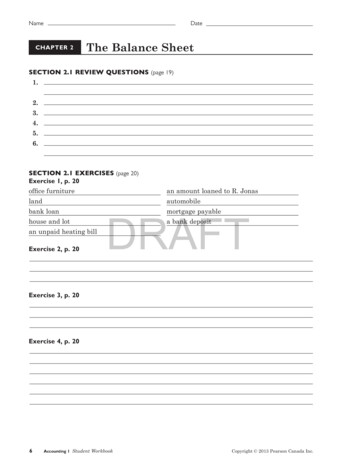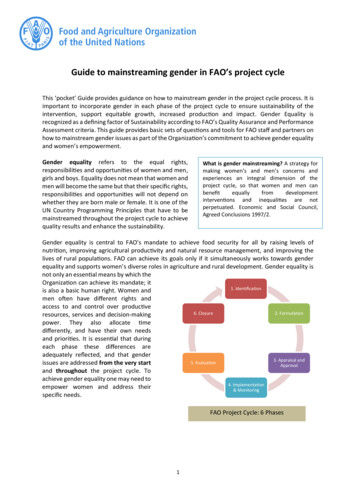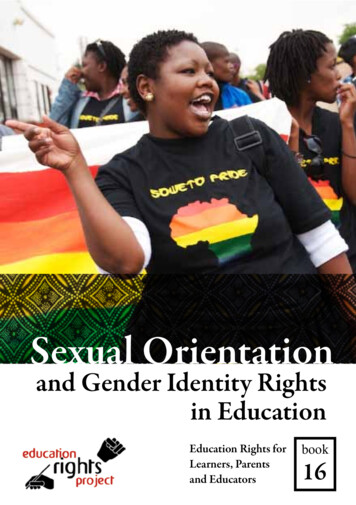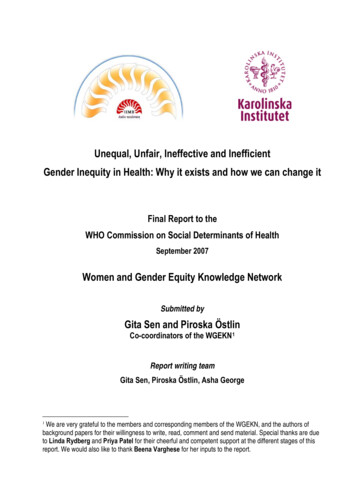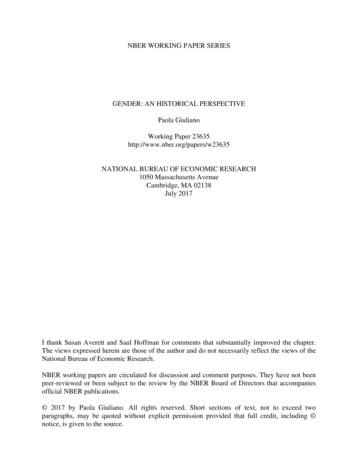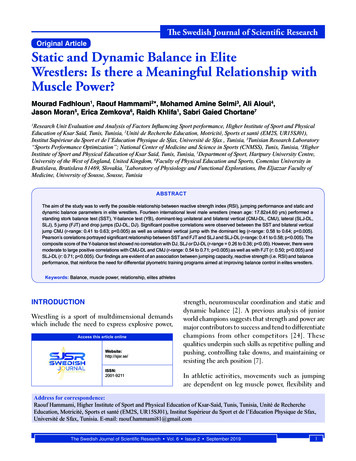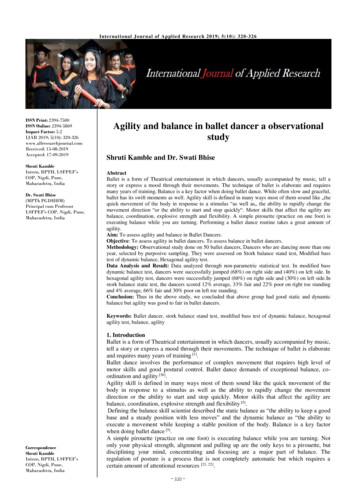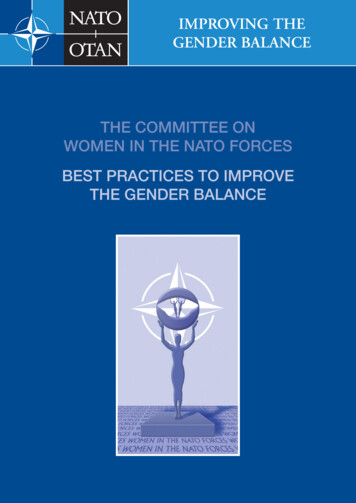
Transcription
IMPROVING THE GENDER BALANCEA SELECTED LIST OF BEST PRACTICESVERSION 20081
TABLE OF CONTENTSIntroduction .5Legend to the list of Best Practices .7I. Best Practices on the Integration of the Gender Perspective intoRecruitment, Summary .81. The physical fitness criteria for the selection of female applicants for militaryservice are regulated .92. Wide spread information campaigns outlining possibilities to develop militarycareers for women and to combine professional and family life by men andwomen .103. Promote equal opportunities between women and men .114. Minimum targets are established for recruitment and education selection forwomen .115. Special consideration is paid to women as a target group in Recruitmentmeasures .126. All women eligible for military service are invited to participate in an informationday at the Recruitment centre or sent a letter outlining the value of militaryservice 127. Postponing physical tests scheduled in the enlistment call, due to pregnancy orchildbirth 138. Balanced composition between men and women in the Recruitment and selectionboards 13II. Best Practices on the Integration of the Gender Perspective intoEmployment, Summary .141. Legal equality .152. Moderate quota system .163. Establishing an institution or committee responsible for issues regarding militaryand civilian women .164. Reassignment or restricted duty during the time of pregnancy or breastfeeding .175. Creation of a Gender adviser .176. Evaluation of measures and indicators on improving the Genderbalance .182
7. National legislation regarding equal opportunities for female and male militarypersonnel .188. Provide Gender awareness Training .199. Special recognition and awards .19III. Best Practices on the Integration of the Gender Perspective intoOperational Planning and Operations, Summary .201. Creation of action plans to implement UNSCR 1325 .212. Gender mainstreaming checklist for Ops Planning and Operations 213. Including gender issues and UNSCR 1325 in all mission-specific pre deploymenttraining .224. Utilization of official statistics disaggregated by sex .225. Implementation of a Gender advisor in all Operations .236. Encourage the participation of female personnel in Operations abroad .237. Increase Recruitment of female personnel .248. Assignment of female personnel .249. Attention to mixed composition of teams .2510. Recognizing female personnel's body differences in the procurement of protectiveequipment and organizational clothing 2511. Separate male and female accommodations and ablutions .26IV. Best Practices on the Integration of the Gender Perspective intoQuality of Life, Summary. . 271. Family support initiatives .282. Work-Life balance initiatives .283. Ensure female personnel are recruited and assigned at reasonable numbers ofrepresentation .304. Diversity policy .305. Material and infrastructure adapted for female personnel .31TABLE OF CONTENTS3
V. Best Practices on the Integration of the Gender Perspective intoEducation and Training, Summary . 321. Gender Education 332. Gender Training .343. Integrated military Training .3435VI. Best Practices on the Integration of the Gender Perspective intoCareer Development, Summary. .1. Promote equal Career opportunities for female personnel through specificprograms 362. Promote family friendly policies .373. Balanced gender composition in selection boards .37Process to update the Best Practices . 38Previous Publications 39TABLE OF CONTENTS4
INTRODUCTIONBackgroundAlongside their male counterparts, military service women have been proudlyserving both their Nations and NATO during critical times of war and mobilisation.They are vital contributors to the worldwide spectrum of activities and operations ofthe individual nations and the Alliance.In 1976 recognising the value of gender integration, NATO s Military Committee(MC) established the Committee on Women in the NATO Forces (CWINF).Composition of the Committee on Women in the NATO Forces(CWINF)The CWINF comprises the Chairperson, three Deputy Chairpersons and oneDelegate from each NATO nation having a representative in the MC. The nationaldelegates are normally senior military personnel working on gender integration anddiversity issues within their Armed Forces. Partnership for Peace (PfP) andMediterranean Dialogue (MD) nations are normally invited to participate asObservers to the annual CWINF Conference.CWINF Conference in 2008 at NATO HQINTRODUCTION5
CWINF MissionThe Committee’s principal mission is to advise NATO’s military leadership andmember nations on critical issues and policies affecting service women in theNATO Forces. It is a consultative body that aims at promoting the most effectiveutilisation of the capability of service women in the Armed Forces throughout theAlliance. Furthermore, it supports the Alliance nation’s information requirementson gender integration by providing informed guidance on gender-related anddiversity issues more specifically, operations-related lessons learned from servicewomen.CWINF Selected List of Best Practices to improve the GenderBalanceThe United Nations Security Council Resolution 1325 (UNSCR 1325) recognisesthe urgent need to mainstream a gender perspective into peacekeeping operationsas it will contribute to the maintenance and promotion of international peace andsecurity. This resolution also calls for increased involvement of women at alllevels, from early conflict prevention to post-conflict reconstruction.In order to improve the gender balance, particularly during operations, andfollowing extensive consultations with NATO’s member nations, the following BestPractices have been selected as a result of the CWINF conference 2008. While itis recognized that not all best practices are supported by or implementable in allmember nations, the CWINF’s intent is to create a repository of essential bestpractices based on national lessons learned, from which nations can draw on theexperience of their allies. While it is not an exhaustive list, the CWINF’s intentionis to continue updating the list as more best practices can be identified andincluded.The Executive Committee and the Team of the Office on Women in the NATO Forces.INTRODUCTION6
LEGEND TO THE LIST OF BEST PRACTICESImplemented:List of the NATO nations that have already implemented or partially implemented(implemented in part) this Best Practice in their national policy, legal regulations,procedures and practices as of June 2008.To be implemented:List of the NATO nations that have taken the decision to implement this BestPractice in their national policy, legal regulations, procedures and practices, buthad not yet implemented as of June 2008.Recommended:List of the NATO nations that support the implementation of the Best Practice, butas of June 2008 have not implemented the best practice nor have any immediateplans to do so.LEGEND7
I.BEST PRACTICES ON THE INTEGRATIONOF THE GENDER PERSPECTIVE INTORREECCRRUUIITTMMEENNTTSS uu mmmm aa rr yy ::1. Thephysical fitness criteria for the selection of femaleapplicants for military service are regulated. During fitnesstesting, the same tests are administered; however standardsand scores are adjusted to recognize biological differencesbetween women and men. All remaining selection tests are thesame.2. Wide spread information campaigns outlining possibilities todevelop military careers for women andprofessional and family life by men and women.tocombine3. Promote equal opportunities between women and men.4. Minimum targets are established for Recruitment and Educationselection for women.5. Special consideration is paid to women as a target group inRecruitment measures.6. All women eligible for military service are invited to participatein an information day at the Recruitment centre or sent a letteroutlining the value of military service.7. Postponing physical tests scheduled in the enlistment call, dueto pregnancy or childbirth.8. Balancedcomposition between men and women in theRecruitment and selection boards.RECRUITMENT8
1.The physical fitness criteria for the selection of femaleapplicants for military service are regulated. During fitnesstesting, the same tests are administered; however standardsand scores are adjusted to recognize biological differencesbetween women and men. All remaining selection tests arethe same.DescriptionThe physical selection test measures the physical potential of the applicant takinginto account biological differences between men and women. The score on thistest is included in the overall score of the applicant. A ranking, of the applicants,based on this overall score is made up.In the case of a limited number of vacancies, the best applicants are recruited.Standards for physical tests related to certain functions (e.g. pilot, combat diver)are the same for men and women.Advantage The test measuring the physical potential of men and women is no longergender neutral.Women are no longer put at a disadvantage, so their chances to be recruitedincrease.Increase of the number of women recruited.Recruitment is seen to be fair and unbiased as the best candidates arerecruited, regardless of their gender.ChallengesPerception of unfairness and a double standard.Implemented byBEL, CAN, CZE, DEU, DNK, ESP, FRA, HUN, ITA, LTU, LVA, NLD, NOR, PRT,ROU, SLV, TUR, USAIn part: GBRRecommended byIn part: POLRECRUITMENT9
2.Wide spread information campaigns outlining possibilities todevelop military careers for women and to combineprofessional and family life by men and women.For example: women are represented in Recruitment centers,campaigns, brochures, leaflets, community-based festivals,events and also on Recruitment websites.DescriptionBy showing women in publicity campaigns, female personnel on the labor marketcan see that a career in the Armed Forces is a possibility.The Services' recruiting organization includes female personnel to ensure a fairgender representation in recruiting activities.School Presentation and Recruiting Teams visit schools, including girl-onlyschools. Recruitment advertising also appears in female oriented magazines.The issues of female soldiers and their position may become an object of interestof a number of nationwide and regional media.Community events are occasions in which to conduct positive outreach and toattract public interest. Military representation at these events should reflect thediversity of the population.Advantage More women will apply for a job in the Armed Forces because they get themessage that women can execute a job in the Armed Forces as well.(Visibility). Increase of number of women. Full spectrum of roles that female personnel can undertake is shown. High interest of women to apply for enlisting. The informal settings ofCommunity-based events are ideal venues for engagement with the public.These events attract people who might otherwise show no interest in themilitary and provide them an opportunity to speak with someone in uniform. The work life experiences of female personnel in different positions provideyoung female personnel with a varied impression of women’s employmentChallenges Unrealistic view of the Armed Forces: if the visibility of women in recruitmentcampaigns becomes too high, these campaigns might lose their credibility. Recruited women may be deceived when they join and realize that therearen't that many women in the Armed Forces at all.Implemented byBEL, BGR, CAN, DEU, DNK, ESP, GRC, LVA, NLD, NOR, POL, SLV, USAIn part: CZE, FRA, GBR, HUN, ITA, LTU, PRT, ROU, TURRECRUITMENT10
3.Promote equal opportunities between women and men.Description Women enter the Armed Forces on a voluntary basis. Women can enter the Military academies equally after passing competitiveexaminations such as medical, psychological, physical fitness as well as apersonal interview. In recruitment, attention is drawn to the fact that applications from womenare welcomed.Implemented byBEL, BGR, CAN, CZE, DEU, DNK, ESP, GRC, HUN, ITA, LVA, NLD, NOR, POL,SLV, USAIn part: FRA, GBR, LTU, PRT, ROU, TUR4.Minimum targets are established for Recruitment andEducation selection for women.Description% of the available places is held for women that are qualified. Determine thepercentage of women to recruit each year and aim to set yearly percentages.AdvantageEffort made by the organization to obtain the goal that has been set.ChallengesPerception of unfairness; the suspicion that less qualified women are let in Limitingfactors such as racks at sea, rating restrictions, seats at training commands,propensity to serve, can make this a challenge.Implemented byCAN, NORRECRUITMENT11
5.Special consideration is paid to women as a target group inRecruitment measures.DescriptionTargeted recruiting focuses on special groups. Specific efforts are made tocommunicate with eligible women to ensure they are aware of their careerprospe
Standards for physical tests related to certain functions (e.g. pilot, combat diver) are the same for men and women. Advantage The test measuring the physical potential of men and women is no longer gender neutral. Women are no longer put at a disadvantage, so their chances to be recruited increase. Increase of the number of women recruited. Recruitment is seen to be fair and .
